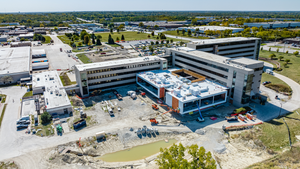The re-urbanization of America
With more consumers living in cities, retailers need to rethink their merchandising efforts.
January 1, 2018
With more consumers living in cities, retailers need to rethink their merchandising efforts. Americans once flocked to the suburbs in search of a better, easier life. Now, it seems as if the reverse is true as more and more people are living in cities across the country—and for a longer time period. This urban growth brings new opportunities for grocery retailers that can be flexible and adapt their thinking and formats to new patterns of demand and land use. The demise of urban sprawl in favor of the “new urbanism” or re-urbanization of America—the reverse migration that has resulted in a multi-generational population shift from suburbs to cities in order to obtain a more economical and cohesive lifestyle—has been described as “work, live, play.” A number of factors are responsible for the changes that are already having an impact on chains and independents. Among them: Higher transportation and energy costs; difficulty of first-time home buyers obtaining mortgages; a growing preference for mixed-use, walkable communities; and younger people—principally Millennials—getting married and starting families later then their baby-boom predecessors. With these factors in mind, many national retailers are realizing that densely populated urban areas are undersupplied and are focusing on scaled down facilities for future growth. This has already been addressed by supermarkets and mass merchants like Walmart, Target, Costco, Whole Foods, Safeway, Aldi, Trader Joe’s and a raft of strong independents in cities like New York, Philadelphia, Chicago, Atlanta, Austin, Raleigh-Durham, San Jose and San Francisco. Even sprawling Los Angeles, where a downtown area was virtually non-existent, is undergoing a transformation brought about by a surging population as well as abandoned and underutilized properties being converted into apartments and new retail space. Retailers like Target, H&M, Urban Outfitters and Victoria’s Secret have already moved into areas that were once skid rows and desolate after working hours. “Cities are getting bigger and denser and retailers need to pay more attention to the top 20 or 30 metro areas where re-urbanization is taking place,” says Tim Wang, director of research for Clarion Partners, the New York-based real estate investment firm. He reasons that the return of baby-boom empty nesters and the lure of employment and an urban lifestyle among Millennials, for whom home ownership is out of reach is a driving force. “I can’t say if re-urbanization is a long term trend,” he says. As a strategist, I’m looking 10 years down the road. When the echo boomers have families and need more space and better schools, will they move back to the suburbs? I don’t know.” For now, the data all points to cites getting larger and denser. “Re-urbanization is taking place in the top 20 or 30 metro areas and retailers need to pay more attention,” says Wang. “Despite some spikes, there are opportunities to get in at affordable rents.” However, urban retailing should not be viewed as low-hanging fruit, according to industry observers. They say inner city retailing requires a totally different mindset. “You have to ask yourself if you’re equipped to take advantage of this opportunity and deal with new issues,” says John Stanton, professor of food marketing for St. Joseph’s University, in Philadelphia. “A lot of stores will have to reach the conclusion that they can’t.” Jim Hertel, managing partner for Willard Bishop, based in Barrington, Ill., agrees. “Many companies have a certain way of doing business,” he says. “Some focus on optimizing distribution by taking costs in everything from merchandising to operations out of the system. But the things that take costs out of a store in rural or suburban areas may be what you need in urban markets. You have to think outside the box and this runs counter to many business models.” As one observer notes, “You can’t solve new urban problems with old suburban business models.” However, preparing for the future also means understanding the factors that shaped the past. Most retail observers and historians trace suburbanization to the late 1940s and 1950s when GIs returning from World War II and then Korea began looking for safer neighborhoods and more spacious homes that would provide a better life for their families. Supermarkets and other retail centers sprang up to meet rising demand. This exodus also resulted in increasing urban decay and a widening “retail gap” in what once were thriving neighborhoods. This trend began reversing itself in the 1980s and 1990s, peaking with the financial crisis of 2008 when home values plummeted and the dream of home ownership became a nightmare of foreclosures. Changing demographics paint an even more compelling picture for urban growth. This is underscored by statistics from the Department of Housing and Urban Development and the U.S. Census Bureau, which forecast that by 2025 only 10% of new households would have children. Some forecasters have gone a step further stating that by 2025 only 25% of all U.S. households will have children.
Census figures also show that for the first time in decades growth in urban areas outpaced the suburbs, with 33 of the nation’s 51 largest cities following this trend, according to 2011 U.S. Census data. In fact, it is estimated that about 80% of the U.S. population now lives in urban areas. Economist and Nobel Prize laureate Robert Shiller, creator of the Case-Shiller Index, one of the most closely followed house-price indexes, says that the glory days of the “exurbs”—farthest suburbs—may be behind us. He cites high gas price and the threat of yet another real estate bubble as reasons. Meanwhile, the unemployment rate in those exurbs rose 126% during the most recent recession compared with 113% in urban areas, according to a 2012 Wall Street Journal/Zillow analysis, published in The Fiscal Times—making it a more economically attractive prospect. Urban upside While not abandoning its traditional “big box,” a drop in weekly shopping trips has convinced Walmart to build a stronger urban presence for formats that include Neighborhood Markets and Walmart Express. In another move, the chain purchased a former Macy’s location in downtown Honolulu for about $26 million and is renovating the 80,000-square-foot space. Officials at Whole Foods say the natural food retailer intends to build more stores in areas like downtown Detroit, Chicago’s Southside and Newark, N.J. Target is testing the 80,000-100,000 square-foot City Target format in Los Angeles, Chicago, Seattle and Portland. Walgreens and Family Dollar Stores are also expanding in urban neighborhoods with a larger selection of fresh foods. Is development of urban strategies a lasting trend? “Yes and no,” according to Hertel. “It all depends on the timeframe you’re looking at. Between 2000 and 2002 there was a lot of growth in far suburbs and people could get bigger houses because they qualified for cheap mortgages. In 2007 and 2008 the growth stopped and people ended up losing their houses. They threw the keys on the table and many headed back to the city. “In the course of our work for retailers we’ve evaluated a lot of stores that are underperforming. We looked at one on Google Earth that had cornfields on one side and ‘MacMansions’ on the other. This retailer figured they’d establish a position and reap the rewards over time as the neighborhood grew around them,” he says. “But a lot of retailers got caught flatfooted.” The real question is whether the pendulum will swing back again as Millennials get older and opt for the same lifestyle as their parents. “It probably will. But it’s like buying futures. The question is when,” says Hertel. Meanwhile, retailers taking up residence in the city have to be prepared to deal with a far more complex customer base. That consumer base includes young urbanites, empty nesters that came back to the city when their kids moved away from home and upscale and economically challenged people all shopping the same store. Observers say meeting this wide-range of consumers’ needs is not as easy as putting a store in the middle of suburbia and figuring you’ll attract mid- to upscale households with kids and the storage space. “It becomes a real balancing act to have the combination of center store variety and service departments that appeal to everyone shopping your store,” says Hertel. “We talk a lot about customization and localization and whether merchandising should be done chainwide, for a cluster of stores or on a store-by-store basis. Urban retailing means classifying stores on a neighborhood-by-neighborhood basis.” Classifying stores on a neighborhood-by-neighborhood basis can be a challenge for retailers and CPG companies. “Manufacturers often want 100% ACV distribution for every size and brand,” says Hertel. “Re-urbanization argues against doing that because of smaller store footprints. You have to think harder about what you’re going to put in the store. Depending on location, you might not want to put in prepared foods. In another neighborhood, supermarkets are a takeout lunch place. People use city stores differently then they do in the suburbs.” If retailers cannot deliver what urban shoppers want, staying away might be the right decision. Of course there are negative consequences to doing nothing when a marketing area is re-urbanizing and new competition comes in. “It’s been described as being nibbled to death by ducks,” says Hertel. “Little individual bites don’t cause a problem. “But as they accumulate you can end up losing half your business and your ability to grow is compromised. Urbanization may run counter to a lot of retail business models. But you have to think outside the box.” Some observers say that urban retailing requires a far less homogeneous approach to food retailing. “Take Philadelphia as an example,” says Stanton. “Some areas are being gentrified by younger customers who want more prepared dinners. Other areas are Hispanic and want more canned fish or Vienna sausages. Another area here is made up primarily of shoppers from West Africa who want something completely different. It’s not like an average store that draws people from the traditional 1.5-mile trading area. You have to target products to specific people.” This may be a challenge for retailers who are used to stocking a 40,000-square-foot store. However, in urban areas a big store is not a necessary requirement to give people what they want, especially when what consumers want can be different just 10 blocks apart. “This means retailers will need a lot more vendors for products that won’t sell on a large scale,” says Stanton. “Or they will have to deal with local producers that ship directly to a store.” In this scenario, large chains may be at a distinct disadvantage. However it is a huge opportunity for independent grocers, who can be better at figuring out a neighborhood. “They don’t need committees or have to carry items mandated by corporate headquarters,” says Stanton. “They can see people buying a product elsewhere and have it in their stores two days later. Big chains aren’t equipped to do that. It throws off their system. They are more interested in cutting costs then selling product.” he says. Urban renewal By most accounts, 2013 was a year of gradual improvement in the economy and real estate markets. A continuation of these trends is expected this year and urban retailing remains one of the high spots for growth, according to the latest retail forecast by Jones Lang LaSalle (JLL), a global real estate service firm. The forecast claims that vacancy rates have trended downward and rents in some markets are inching upward. Yet, the report says that there are still significant constraints. According to the report, “consumer confidence, while trending upward, remains elastic—dependent on external factors like fiscal policy and the stock market. Given this economic landscape, we expect modest growth in absorption. Vacancy rates should continue to inch down 30% over the next year as construction remains limited. Rents, having found their bottom, will head upward and gains will become more widespread across more markets. The lack of new supply will continue to tighten retail fundamentals next year.”
Turning to urban retailing, specifically, the company says that in-migration into urban cores is expected to continue. These are the areas favored by the younger Millennial generation who are trying to build a life in more vibrant city areas. In fact, 48% of those surveyed live in downtown areas or cities located just outside downtowns. Baby Boomers looking to downsize are also attracted by walkable urban communities. Conversely, suburban malls continue to be characterized by polarization. Competitive malls are defined as those with an 80% occupancy rate. Non-competitive locations will continue to have trouble signing new tenants due to low traffic and too many vacancies, reads the report. Power centers have seen phenomenal growth despite some vacating big box retailers like Borders. However, in many cases they are being replaced by discounters, the survey says. In another report, the company states that migration into the urban core will have a profound impact. “The population growth around top-tier office space demonstrates the increasing demand for centrally located living. The preference of people to live near their work is high and increasing and leading to premium rents in these locations. This is fueling apartment development that will further accelerate population growth near many downtowns,” say officials from JLL.
About the Author
You May Also Like




